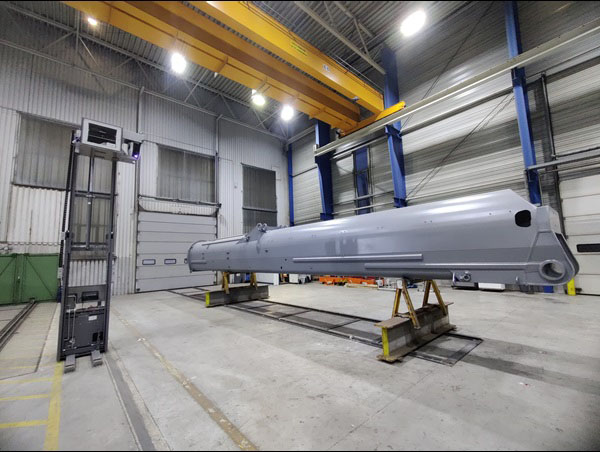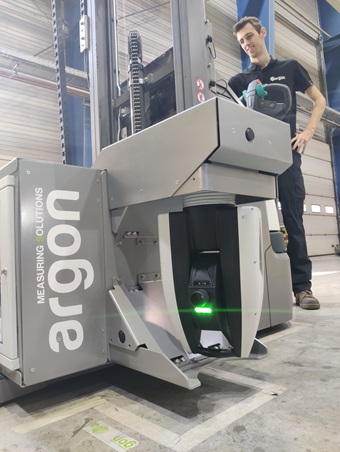Incorporación de inspección automatizada 3D sin contacto para estructuras soldadas
By Rodrigo Alfaia, Associate Director Laser Tracker, Hexagon’s Manufacturing Intelligence division

Engineering Reality 2024 volume 1
Accelerate Smart Manufacturing
Con centros de producción en Bélgica, Alemania y Polonia, el Grupo Vlassenroot es un proveedor líder de estructuras y componentes complejos de acero a medida. Sus actividades consisten en el corte y plegado, así como la soldadura, el mecanizado, ensamblado y pintura de componentes de acero avanzado para diversas industrias como la elevación, el ferrocarril y la energía. Con sus orígenes principalmente en el suministro de semicarcasas curvadas para grúas, la empresa familiar ha crecido hasta suministrar plumas telescópicas, chasis y plataformas giratorias según las necesidades del cliente.
Un área especial en la que Vlassenroot se enfrenta a grandes desafíos es la producción de plumas telescópicas. Las plumas con una longitud de hasta 16 metros deben acoplarse perfectamente entre sí para cumplir con las exigentes normas de los fabricantes de grúas en cuanto al comportamiento elástico y la capacidad de carga del telescopio.
Para aumentar el rendimiento de la producción y reducir los tiempos de inspección, la planta alemana de Vlassenroot contrató a ARGON Measuring Solutions para desarrollar una solución de inspección 3D fiable que pudiera formar parte del proceso de producción.
La solución propuesta por ARGON se basa en el láser tracker de escaneo directo Leica Absolute Tracker ATS600 de la división Manufacturing Intelligence de Hexagon, instalado en un carro de medición, un apilador de palés estándar eléctrico optimizado para fines de metrología.
La producción de plumas plantea grandes desafíos al fabricante
La producción de plumas telescópicas largas para la industria de grúas móviles se realiza en varias etapas. Los principales elementos son las semicarcasas de acero, provenientes de la planta belga en Bruselas, que se unen mediante soldadura híbrida en un solo tubo que constituye uno de los elementos de la pluma telescópica.“A pesar de que nuestros soldadores son expertos, queríamos reforzar la rutina de inspección y hacerla menos dependiente de la precisión de cada operario,” explica Philippe Dudzik, Director industrial en Vlassenroot. Entre los detalles que es necesario comprobar con precisión se incluye la calidad del cordón de soldadura y la influencia del calor inducido en las deformaciones del material.
“Aún no entendemos con detalle el efecto de estas deformaciones del material, es decir, qué parámetros de las fases previas de la producción influyen en el nivel de torsión del material,” explica Dudzik. “Los datos digitales que recibimos ahora del ATS600 en varias fases de la producción nos permiten definir parámetros importantes y deformaciones de la pluma.”
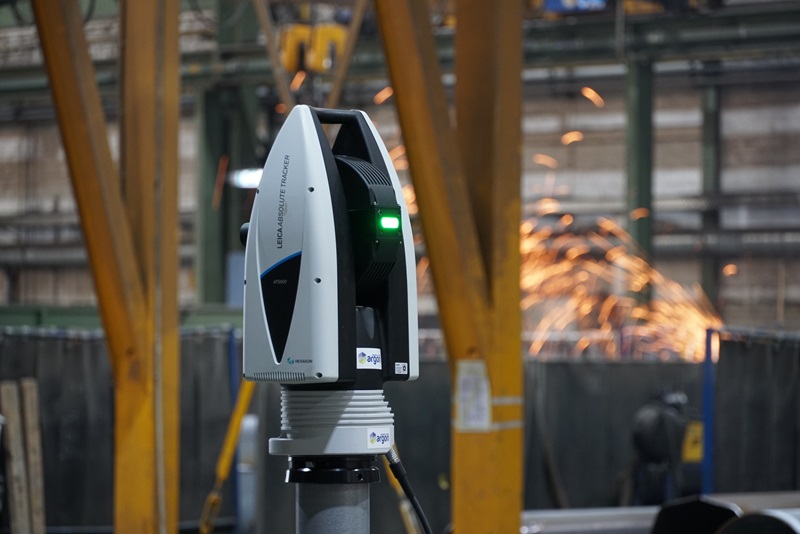
La producción de grandes componentes de acero genera polvo y vibraciones, por lo cual los equipos de las instalaciones de Vlassenroot deben ser capaces de soportar un entorno de producción adverso.
“Todo este proceso requiere mucho tiempo y experiencia de nuestros empleados,” comenta Dudzik. “La instalación de un proceso de calidad con controles de calidad bien definidos detectará plumas que no requieren pasar por el proceso de enderezamiento. Para las que sea necesario, sabremos inmediatamente dónde corregirlas. Esto nos ahorrará tiempo y dinero. Y al medir con más rapidez y fiabilidad, podemos entender mejor las causas de las desviaciones y, por tanto, anticiparnos mejor a ellas y evitarlas.”
Instalación de controles de calidad para aumentar la eficiencia
Junto con ARGON, Vlassenroot estableció diversos controles de calidad durante el proceso de producción. Basado en esto, ARGON desarrolló una solución innovadora para Vlassenroot, proponiendo un sistema con un Leica Absolute Tracker ATS600 de escaneo directo instalado en un carro de medición ARGON. 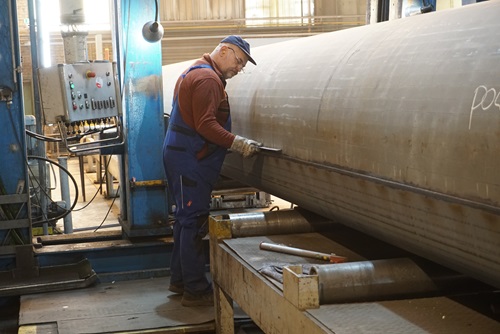
En el pasado, la comprobación de las desviaciones en la pluma era una tarea puramente manual: mediante calibradores y calibres, un empleado experimentado capturaba las desviaciones de forma a lo largo de la pluma.
Mediante comprobaciones de calidad adicionales, Vlassenroot pretende reducir drásticamente el número de plumas que se vuelven a trabajar. La comprobación de la calidad de ambas semicarcasas – la base para todas las plumas – representa el primer control de calidad. Se ha configurado un nuevo espacio en la planta de producción dedicado a los procedimientos de medición para plumas en diferentes etapas de producción. Aquí, el ATS600 instalado sobre el carro de medición puede colocarse de forma flexible según sea necesario, según la gran variedad de tamaños de piezas.
En un segundo control de calidad, la pluma soldada se revisa para detectar si el proceso de soldadura tuvo algún impacto sobre el material y si el calor ha causado deformaciones, contribuyendo a las deformaciones del material mencionadas anteriormente.
El tercer control de calidad se instala justo antes del proceso de enderezado. “Mi intención justo antes del enderezado era obtener los resultados de la medición en un mapa de colores que mostrara todas las deformaciones con datos de gran detalle.” dice Dudzik. “Luego utilizamos los datos para diseñar fijaciones que eviten deformaciones durante el proceso de soldadura.”
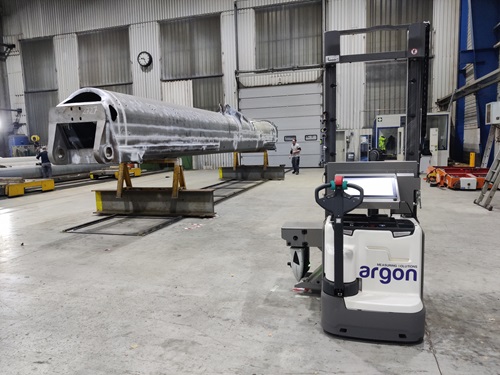
Con el laser tracker ATS600 montado en su carro de medición, ARGON creó una solución de taller altamente móvil para Vlassenroot

Vlassenroot se especializa en la producción de plumas telescópicas para grúas con longitudes de hasta 16 metros. Imagen: © Argon
Dudzik y su equipo van más allá: “Planeamos instalar más controles de calidad y encontrar formas de utilizar los datos que se obtienen. Después de comprobar las semicarcasas, es posible compartir los datos con la planta de Bélgica, permitiéndoles ajustar sus máquinas de doblado y producir las plumas con mayor precisión. Nuestra justificación para los controles de calidad y por consiguiente para nuestra inversión en la solución ATS600 para el taller consiste en incrementar desde el principio la producción y evitar el reproceso.”
La necesidad de una medición sólida y móvil a la vez
Junto con ARGON, Vlassenroot comenzó el proceso de especificar su nuevo sistema evaluando equipos de medición que fueran rápidos, precisos y, lo más importante, lo suficientemente resistentes para hacer frente al entorno adverso de producción. “En nuestras instalaciones tenemos que lidiar con polvo y vibraciones”, explica Dudzik. “Teníamos nuestras dudas a la hora de encontrar un dispositivo que pudiera hacer frente a este entorno”.En comparación con el pasado, las mediciones obtenidas con la nueva solución para el taller basada en el ATS600 son sencillamente mucho más rápidas, con una reducción del tiempo de inspección de hasta el 80%, y eso sin errores de medición. “Los resultados han sido excelentes,” comenta Dudzik. “Y todo ello con una formación mínima.”
